#britishroadside
Explore tagged Tumblr posts
Text
"Little Chef's Puzzle Time" worksheet (Early 1980s)
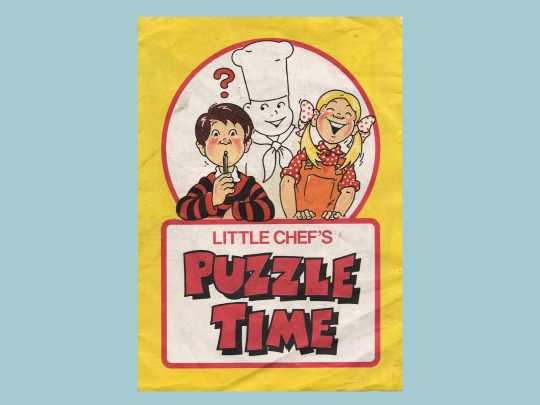
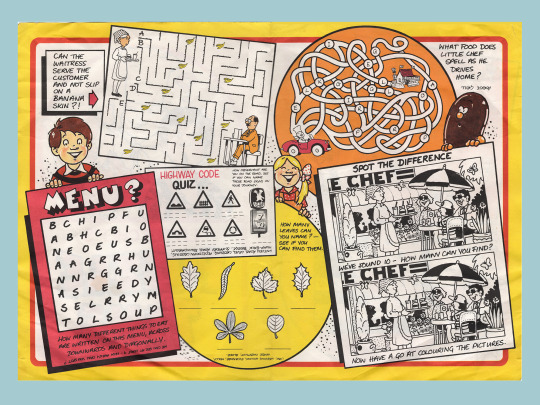
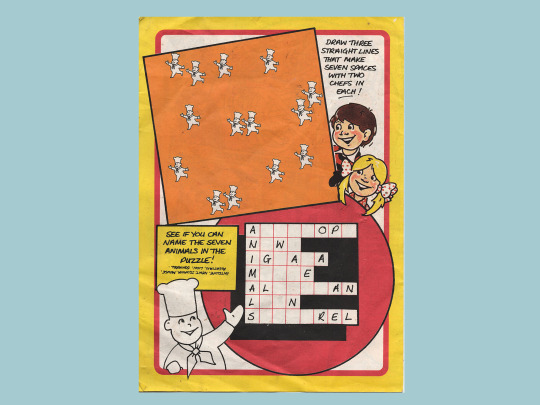
Here is a children's puzzle worksheet from Little Chef, which is from sometime around the early-to-mid 1980s.
Named Little Chef's Puzzle Time, it features numerous Little Chef themed puzzles intended for a child to do at their table when waiting for their food. My personal favourite has got to be the one with Charlie (or as he is referred to here: Little Chef) is driving home - while what I assume is an animate sausage looks concerned as to what is being spelled out in the puzzle. Also I think the waitress on the banana puzzle needs to sue for unsafe working conditions.
Is it just me or is the puzzle on the back with the three straight lines weirdly difficult? It took me about 10 minutes to work it out…
#little chef#britishroadside#retro#uk#littlechef#roadsiderestaurant#roadside#retro worksheet#puzzles#puzzle
1 note
·
View note
Text
"Early Starter" Little Chef Postcard (Late 1980s)
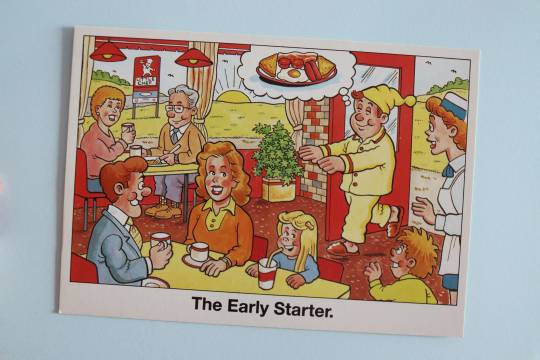
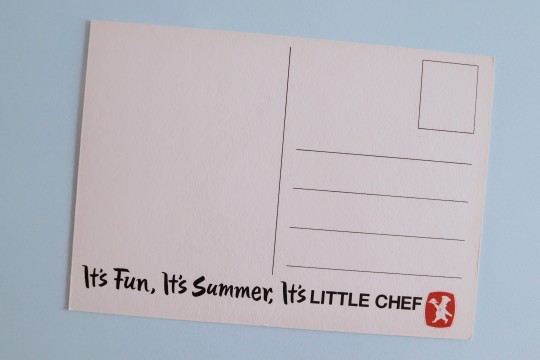
Another of Little Chef's "It's Fun, It's Summer, It's Little Chef" promotional postcards from the late 1980s.
This particular one advertises the Early Starter - Little Chef's most well-known breakfast at the time. As a play on its name, this postcard features a sleepwalker wandering into a Little Chef restaurant for an Early Starter.
Much like the rest of the postcards, this one was drawn by cartoonist Ed McHenry - but peculiarly it is the only one of the three not noticeably signed by him. Like the rest of the set, the back features just the campaign slogan and logo.
Highlights of the illustration include the Little Chef sign that is outside on the left, as well as the cartoonified Little Chef interior.
#roadsiderestaurant#littlechef#its fun its summer its little chef#little chef#roadside#britishroadside#uk#retro#postcard#retro advertising#retro ads
1 note
·
View note
Text
1970s Welcome Break badge

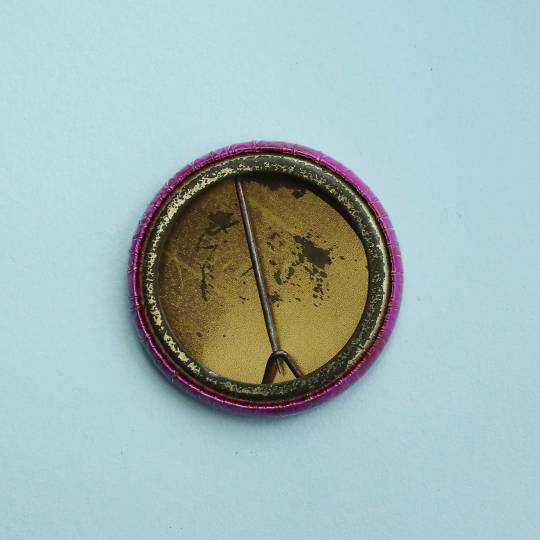
Here's perhaps my favourite of the old badges in my collection. This is a badge for a relatively obscure diner chain that operated in the 1970s on A-roads in southern England. It was a chain called... Welcome Break.
Yes - this is a very familiar brand name around here as it's the name of the second largest chain of motorway service areas. But modern Welcome Break was formed in 1983, a while after this chain closed. So what happened here?
To start, original Welcome Break has interesting origins. It emerged as a result of the disastrous merger between Trusthouses and Forte - two huge hospitality brand names in the early 1970s. Charles Forte talks at length of his side of the story in his 1980s autobiography if anyone fancies a detailed reading of it, but to summarise and simplify the story: Trusthouses and Forte's management did not get on well together... at all. The two businesses had two completely different managerial styles which quickly caused rifts between the two sides. The whole situation got so severe that Allied Breweries, a similar big company, tried to buy out the merged Trust Houses Forte (THF) after spotting the group's increasing weakness. True to the situation, both sides disagreed immensely on whether to let Allied take over. Team Trusthouses wanted the merger, Team Forte did not. In the end, Forte's side won and Allied quit. As a result of this and the general unhappiness with the THF merger as a whole, a whole wave of Trusthouses staff left the company here. Two names of these leavers key to this story are Michael Pickard and Allen Jones.
Both men decided that they wanted to rival the company they once worked with. They both went to roadside catering, setting up their own chains to rival THF-owned Little Chef. Michael Pickard set up Happy Eater - and Allen Jones set up Welcome Break.
Original Welcome Break roughly operated from about 1972 till 1978. Little is documented on the chain, but it gained about 11 restaurants, many located within small villages on busy a-roads.
This badge was likely handed out at one of these sites as a promotional item, and like other badges shown on here recently it has a noticeable resemblance to the famous yellow badge of it's rival.
The logo of Welcome Break here is interesting - the chain's original name was to be Mr Chef and I wonder if this logo was designed for that name considering the overall design. Similarly, from a distance it looks an awful lot like a certain Chef rival's logo... or is that just me?
Allen Jones and Michael Pickard would strike a deal c.1978 to merge their two chains, and Happy Eater was chosen to be the unified chain's brand – ending the Welcome Break chain. The Welcome Break name would however remain owned by Happy Eater.
Happy Eater would be bought by big conglomerate Imperial Group in the early 1980s. It just so happened that at the same time, Imperial had recently gained control of food company Ross' four motorway service areas - and clearly looking for a new name, decided to reuse the former diner chain’s name for a new motorway service area operator. And thus modern @welcomebreak was created.
In a twist, both Happy Eater and new Welcome Break would be bought out by THF themselves in 1986, New Welcome Break was merged with their existing motorway service areas - with the whole chain taking the Welcome Break brand, in a way not dissimilar what had happened with Happy Eater and original WB nearly a decade prior.
#uk#britishroadside#graphic design#retro#badges#happyeater#little chef#motorway services#badge#welcome break#roadside#roadside restaurant
1 note
·
View note
Text
I am a Little Chef Badge (1970s)


This is a tiny badge for Little Chef, made sometime in the early to mid 1970s.
It was presumably handed out in restaurant as a promotional item, much like their famous lollypops. However, similar to the Kelly's Kitchen badge I showed here previously, this particular badge has a distinct similarity to a famous yellow badge made by one of Little Chefs rivals. But here, the recipient is instead dubbed a "Little Chef". Hm.
This badge is especially interesting when it comes to the version of the logo it uses. Charlie here looks rather different, and that is because this is an earlier version of the famous logo. Charlie here is a little wider and less defined than his later counterparts, and instead of staring at the viewer, he concentrates on his tray. Perhaps he's less confident in his chef abilities?
The familar LC logo would be introduced a few years after this badge was produced, with it first appearing in the late 1970s.
Producing own versions of the Happy Eater badge was, looking at it now, a common trend in the 1970s and 80s roadside restaurant industry. Infact this isn't even the last badge I have in my collection which has a distinct similarity. I suppose it demonstrates the power these badges must had back in the day - both as a promotional item and as an icon of the roadside.
#little chef#littlechef#uk#roadside#roadsiderestaurant#retro#badges#britishroadside#graphic design#motorway services#badge
1 note
·
View note
Text
Kelly's Kitchen Directory and Map pamphlet (1989)



Here’s an item which I originally found quite literally attached to the badge from the last post (hence the unfortunate holes and circular dents). This is a map for the pretty-much-obscure former British roadside restaurant chain Kelly's Kitchen - one time rival to Little Chef and Happy Eater. More info on them in the previous post.
This pamphlet is fairly special: for one thing I’ve never seen another one like it - but on the other hand, and more importantly, the information it has gives us some very interesting details on the Kelly’s Kitchen brand during this period.
On the front, we have the logo featuring who I presume is mascot Kelly, as well as a Birmingham headquarters address. A quick google shows this particular address to be a fairly fancy building round the side of Broadway Plaza entertainment complex. It is now also apparently home to a recruitment agency.
On the back, they give us a lovely view of their locations. There's a noticeable congregation in the Midlands and Anglia (perhaps an area relatively underserved by Little Chef and Happy Eater?) as well as a location each in Scotland and Wales. But wait - there's more branches displayed here than were actually opened: Kelly's Kitchen only made it to about 18 until they were bought and absorbed into the Little Chef chain. So why is this?
This is where the middle section of the pamphlet explains what's happening. The management of Kelly's Kitchen were apparently so sure of their expansion, they printed this map with all of their locations (opened and unopened) on it regardless of if they had started construction or not. We can tell that last part as some of these "future" branches quite literally never existed - let’s take a look at each of them:
Kilmarnock (A71 and A76): Was not built as a Kelly's Kitchen, instead became a Little Chef and was built in their standard design.
Barthomley (M6 and A500): one of the few which actually did open as a Kelly's.
Appleby Magna (M42 and A444): At the existing service area, never built.
Marks Tey (A12): Never built - not even 100% sure where this one was meant to be.
Brentwood (A12): Was actually built and likely opened as a Kelly's.
Orsett Cock (A13, double-sided): Never built, west side became McDonalds, east side a Little Chef.
Maresfield (A22 and A26): Never built, instead became a Little Chef much later.
Beckington (A361 and A36): Was not built as a Kelly's Kitchen, instead became a Little Chef and was built in their standard design.
Emsworth (A27): Was not built as a Kelly's Kitchen, instead became a Little Chef and was built in their standard design.
So yeah, in hindsight a very interesting decision to include these branches on the list. But I suppose this is exactly why this pamphlet so interesting to look at now - it's a glimpse at what could have happened if things had gone differently for the british roadside as a whole.
#kelly's kitchen#britishroadside#uk#graphic design#retro#little chef#happyeater#motorway services#motorway#aroad#maps#pamphlets#roadside
0 notes
Text
Kelly's Kitchen badge (c.1989)
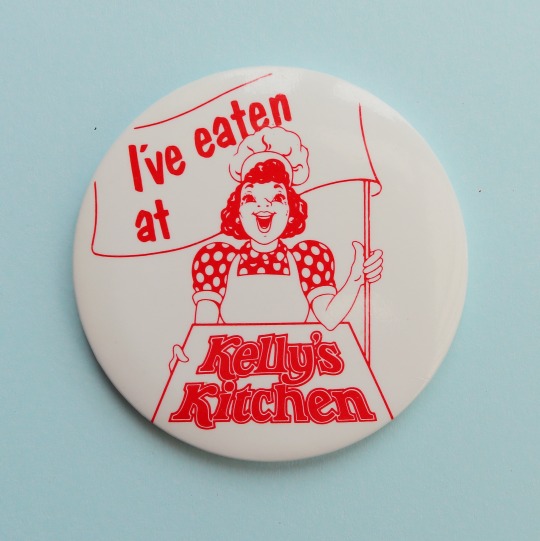
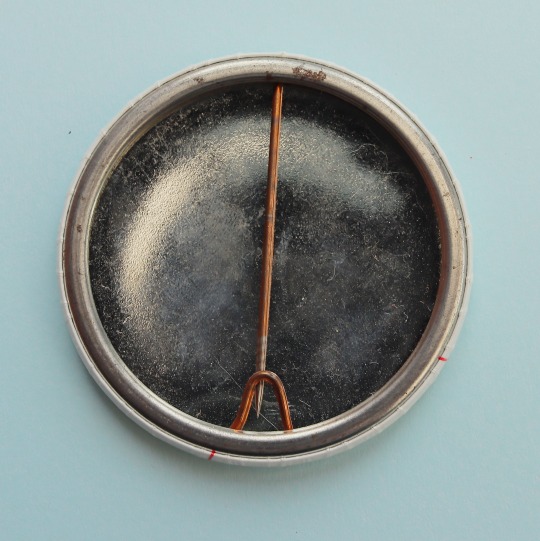
Kelly's Kitchen is on the more obscure end of former British roadside restaurant chains. A rival to Little Chef and Happy Eater, the chain and it's management had high hopes for the brand in the 80s. They wanted it to become the second largest chain in the industry - ahead of Happy Eater but still behind the huge Little Chef chain. The chain did have indeed success and rapid expansion for a while - quickly opening up branches in the Midlands. This was partly as a result of its big company backers: first Norfolk House/Petrofina, and later Bass through their subsidiary Crest Hotels. But I did write "obscure" in that introduction - the Kelly's Kitchen chain only lasted for about four years (1987-1991). The end came about when Trusthouse Forte, the huge hotel and catering company who just so happened to own both Little Chef and Happy Eater, bought the Crest Hotels chain - a sale which included Kelly's Kitchen. As a result, Kelly's Kitchen got absorbed into the already mammoth Little Chef chain, a decision which was perhaps the noticeable start of what would soon become a big problem on the roadside in the 1990s - too many Little Chefs, and not much else. This didn't go well in the end. But onto the object itself. This badge is a promotional item for the chain from it's time of rapid expansion. There's a noticeable resemblance to a certain yellow badge one of Kelly's Kitchen's rivals was famous for giving out, which I'm sure was totally not at all intentional whatsoever. This badge is much bigger, which I think says a lot about the aspirations the business people behind the chain had for Kelly and her numerous Kitchens. When I bought this badge, something else came with it attached to the pin which is so interesting in itself it will get it's own post soon.
In terms of it's legacy still visible on the roadside today, Kelly's Kitchen has one particularly strange one:
It has a roundabout named after it in Milton Keynes.
Yes. For real. Here you go. https://tinyurl.com/humhmtv8
For those wondering why this exists - the adjacent service area used to have a Kelly's Kitchen (demolished to become a McDonalds) and the name must have stuck so much it became the place's official name.
As well as that, there is still a good few former Kelly's Kitchen buildings dotted about, notable as they have a rather distinct design involving a brick shaped funnel and an overhanging Mansard roof (see here on MSO: https://motorwayservices.uk/Kelly%27s_Kitchen#/media/File:Kellys_Kitchen_Fradley.jpg).
0 notes
Text
Happy Eater - Family Badges: Motorcyclist (1980s)


Happy Eater - at certain points throughout their history - released numerous variations of their famous pin badge. This motorcyclist is from the most notable collection of special badges - a set of 6 badges featuring a Happy Eater "Family". In this set, the badge's famous yellow background is ditched for white, the famous "I'm a Happy Eater" caption replaced with just the restaurant's name, and characters which are presumably relatives of Mr Happy (the distinctive mascot for the chain) are displayed instead of him. Unfortunately I don't know much about the set as there's not much I could find written about them. I suspect they are from sometime around the mid to late 1980s based on the characters' clothing as well as the overall design of the badges. As well as that, I suspect there was different levels of rarity for each badge in the set, with some being common and others being rare. I think this motorcyclist is one of the rarer ones as I haven't seen too many of them online compared to some of the others. I have a few more of the variations from this set, so will be posting more soon.
0 notes
Text
Happy Eater badge (this version - 1980s-1996)


The I'm a Happy Eater badge is one of the most iconic items of the late 20th century British roadside. They were created for Happy Eater, a roadside restaurant chain which operated in England and Wales from 1973 to 1996. Happy Eater's main demographic was children and their families, and many of their sites catered themselves to children by having themed fiberglass playgrounds and Lego tables.
Alongside the play facilities, if a child guest had been well behaved, they would be given one of these badges after the meal. If they collected 10, they could trade them in for a special version with a gold trim.
Over the years many variations of the Happy Eater badges were produced. This particular one pictured is a later version of the standard design. You can determine the age of a particular Happy Eater badge through two main ways: by the badge's backing - earlier versions are completley metal, later versions (such as this one) have one component made of white plastic; and by the discolouration of the logo - Happy Eater badges are particularly prone to fading over time.
All Happy Eaters became branches of their rival Little Chef in 1996 - although many of their buildings still stand in many places throughout the UK.
#1990s#1980s#britishroadside#badge#happyeater#happyeaterbadge#littlechef#motorwayservices#uk#retro#retrobadge#newaccount
1 note
·
View note